In 2026, finance leaders aren't asking whether they need AI in their planning workflows; they're asking how to begin implementing it.
Markets are moving faster than ever. Budget assumptions go stale in weeks, not quarters. Your business has likely added new revenue lines, cost centers, and geographies faster than your spreadsheet models can keep up. Finance teams need tools that can:
- Spot risks before they appear on dashboards
- Forecast performance based on real-time data
- Free up analysts to focus on strategy, not number wrangling
AI isn’t a silver bullet, but in the right FP&A platform, it becomes a powerful co-pilot. Think faster scenario modeling, natural language insights, and instant anomaly detection. AI helps FP&A teams create a new reality—one where time spent on low-leverage tasks is minimal and they actually have time to work on strategic insights as they were meant to.
This buyer’s guide explores the top 9 AI-powered FP&A tools available in 2026. We get into what makes them different, what features to evaluate, and how to pick the right one for your team.
Top 9 AI FP&A tools in 2026 at a glance
Drivetrain: An AI-native FP&A platform built for fast-growing B2B companies, offering conversational planning, intelligent forecasting, and rapid implementation.
Anaplan: A connected planning solution with AI-powered scenario optimization for large enterprises with complex modeling needs.
Pigment: A modern, collaborative planning platform with visually intuitive modeling and AI agents for dynamic forecasting and scenario building.
Workday Adaptive Planning: A unified planning tool that leverages Workday’s ecosystem for predictive workforce planning and AI-enhanced forecasting.
SAP Analytics Cloud: An enterprise-grade planning and analytics suite with native SAP integration and AI-driven forecasting and insights.
Planful: A structured FP&A platform focused on repeatable planning processes, AI forecasting, and close management automation.
Cube: A spreadsheet-native FP&A tool that layers automation and AI-driven insights onto Excel and Google Sheets workflows.
Datarails: An Excel-based FP&A solution with AI-powered forecasting, anomaly detection, and variance explanations for SMB and mid-market teams.
Vena Solutions: An Excel-native platform powered by that combines planning, reporting, and predictive analytics.
| Tool | Best for | AI capabilities |
|---|---|---|
| Drivetrain | Mid-market to enterprise businesses | • AI Analyst (conversational interface to surface insights) • AI model generator for automated financial model creation • AI Anomaly detection across revenue, spend, and headcount • AI Transforms (natural-language data transformation) |
| Anaplan | Enterprise businesses | • PlanIQ (ML forecasting engine) • CoPlanner (conversational AI assistant) • Predictive Insights • Optimizer for scenario optimization |
| Pigment | Enterprise businesses | • Planner Agent (next-step recommendations) • Modeler Agent (formula writing, model optimization) • Analyst Agent (trend detection, narrated insights) |
| Workday Adaptive Planning | Enterprise businesses | • AI forecasting and scenario modeling • AI-driven planning assistant (conversational interface) • Anomaly detection for revenue and expenses |
| SAP Analytics Cloud | Enterprise businesses | • Natural language queries • Smart insights and data grouping • Predictive planning with real-time updates • Time-series forecasting • AI-generated dashboards and narratives |
| Planful | Mid-market businesses | • Planful Projections Forecasting Engine (ensemble modeling) • Planful Signals for anomaly detection • Conversational AI interface for natural-language insights |
| Cube | Mid-market businesses | • Conversational Agent (Slack/Teams interface) • Analysis Agent for contextual variance explanations • Forecasting Agent (scenario planning) • Mapping Agent (English-to-rule translation) |
| Datarails | Small to mid-sized businesses (spreadsheet-native) | • Chat (conversational assistant) • Insights (automated reports) • Storyboards (narrative presentations) |
| Vena | Mid-market businesses (spreadsheet-native) | • Conversational AI assistant for Excel and Teams • Automated report generation from simple prompts • Built-in financial analysis to flag trends and anomalies • Learns from user input to improve personalization |
Drivetrain is our top pick for AI FP&A tools to add to your evaluation. Drivetrain is an AI-native business planning platform, purpose-built for the demands of modern finance teams. With 800+ native integrations, Drivetrain eliminates manual data consolidation and refreshes your reports automatically, giving you up-to-date visibility into revenue, expenses, headcount, cash flow, and more. AI capabilities like anomaly detection, natural language queries, and auto-generated insights help teams focus less on grunt work and more on decision-making. Drive AI is a suite of capabilities that includes model generation, anomaly detection, and surfacing insights using the English language.
AI analyst: A conversational interface that lets you ask questions like “Why did revenue dip last month?” and get back clear, contextual answers with charts, variance breakdowns, and links to the underlying drivers.
AI model generator: Builds a full financial model in one click using data from your ERP, CRM, HRIS, and billing systems. It automatically selects key metrics, applies relevant business logic, and creates a flexible baseline forecast that you can adjust.
AI anomaly detection: Scans live data across revenue, spend, cash, and headcount to flag anything unusual. Whether it’s a data quality issue or a business trend shift, the system notifies you before it turns into a problem.
AI transforms: Dig deep into your data with plain-English commands. Ask Drive AI to “split revenue by product and region” or “filter for churned customers with ACV > $100k,” and it instantly delivers clean, structured outputs.
Anaplan is a cloud-native enterprise planning platform built to help large organizations connect strategy to execution across finance, operations, and business units. At the core of Anaplan is its proprietary Hyperblock™ engine, which allows users to build flexible, multi-dimensional models that update instantly as assumptions change. This makes it possible to run complex “what-if” scenarios, reforecast dynamically, and respond quickly to market shifts; critical for today’s fast-paced business environment.
PlanIQ (ML forecasting engine): Automatically builds and refines time-series forecasts using internal and external data. Continuously adapts models as new actuals come in, and highlights confidence levels to help teams trust and adjust projections.
CoPlanner (conversational AI assistant): Lets users ask questions like “Show Q3 headcount forecast” or “What’s driving margin?" in plain language. It surfaces answers, charts, and suggested actions across connected business models.
Predictive Insights: Continuously scans planning data for patterns and correlations, flagging hidden opportunities or risks—like rising churn or seasonal spikes—before they leave the forecast.
Optimizer: Uses algorithms to find the best outcome across millions of possibilities. Whether it’s scheduling, pricing, or supply planning, it considers your business constraints and objectives to recommend the most efficient solution.
Pigment brings a distinctly modern, visually driven approach to business planning, combining AI capabilities with an interface designed for the collaborative, real-time planning processes that define today's high-growth organizations. The platform excels at making complex financial models accessible to business users while maintaining the analytical depth required for enterprise-grade planning scenarios.
Planner Agent: Acts on insights by proposing structured next steps based on goals and market context. Whether updating weekly forecasts or stress-testing scenarios, the Planner Agent handles the heavy lifting automatically.
Modeler Agent: Builds and optimizes your planning models. It writes formulas, flags model inefficiencies, updates workflows, and ensures models stay clean and accurate as your business evolves.
Analyst Agent: Scans both internal and external data sources to surface trends, detect anomalies, and reveal what’s driving your key metrics. It delivers insights in dashboards, visuals, or even narrated audio, helping you quickly understand performance shifts.
Workday Adaptive Planning leverages the broader Workday ecosystem to deliver AI-enhanced planning capabilities that seamlessly integrate with HR, financial management, and operational data sources. The platform's strength lies in its ability to create truly connected planning experiences that span traditional departmental boundaries, enabling organizations to model workforce changes, financial impacts, and operational implications within a unified planning environment.
AI forecasting and scenario modeling: Automatically generates forecasts by blending historical financials with operational data like hiring velocity and sales pipeline. The system adapts as new numbers arrive and lets teams easily model different scenarios.
AI-driven planning assistant: A conversational interface enables natural language queries about your data and recommends actions based on generative AI, helping guide planning workflows.
Anomaly detection: Adaptive Planning flags unusual patterns in your metrics, such as sudden revenue drops or expense spikes, so teams catch surprises before they impact monthly reports.
SAP Analytics Cloud
SAP Analytics Cloud represents SAP's vision for integrated enterprise performance management, combining planning, analytics, and business intelligence capabilities within a single platform that leverages SAP's extensive enterprise software ecosystem. The platform excels in environments where organizations need deep integration with SAP ERP systems and comprehensive data connectivity across the entire SAP technology stack.
Natural language queries: Ask questions like “What drove cost increases last quarter?” and get instant answers through visuals or tables, without setting up filters or custom dashboards.
Smart insights and grouping: The platform automatically detects trends, correlations, and anomalies in your data. It also groups similar data points to uncover hidden segments or patterns, without needing manual rules.
Predictive planning: Built-in AI forecasts future performance using historical and real-time data. These forecasts can be integrated directly into your financial plans and updated as new inputs arrive.
Time-series forecasting models: Finance teams can generate forecasts with confidence intervals and simulate what-if scenarios to test the impact of changes like churn, headcount, or pricing adjustments.
AI-generated dashboards and narratives: Generative AI helps build charts, layouts, and executive summaries for board-ready reports based on the data in your models.
Planful delivers comprehensive corporate performance management with a focus on structured planning processes and AI-enhanced automation. It targets organizations that prefer systematic, repeatable planning methodologies over highly flexible modeling approaches. The platform excels at supporting traditional planning cycles while incorporating modern AI capabilities that improve accuracy and reduce manual effort.
Planful Projections Forecasting Engine: Advanced ML algorithms that automatically select optimal forecasting methods based on data characteristics, with ensemble modeling that combines multiple approaches for improved accuracy
Planful Signals Anomaly Detection: Real-time monitoring of financial metrics with adaptive thresholds that learn normal business patterns and provide intelligent alerts for unusual variances or data quality issues
Conversational AI: Natural-language queries for financial insights: ask questions like “What caused our Q1 variance?” or “Show me forecasted revenue,” and instantly get charts, tables, and narratives.
Cube represents a fundamentally different approach to FP&A automation, focusing on enhancing existing spreadsheet workflows rather than replacing them with entirely new planning paradigms. The platform recognizes that Excel and Google Sheets remain the preferred interfaces for many finance professionals and added AI capabilities into these familiar tools rather than forcing users to adopt new software interfaces.
Conversational Agent: Ask questions like “Why did revenue dip in Q4?” or “Show forecasted ARR by segment” in Slack, Teams, or Cube’s web interface. Get back real answers, supported by data, without filters, pivot tables, or manual digging.
Analysis Agent: Cube flags material variances in your actuals vs. plan and explains the drivers behind those changes in context, helping finance teams get to the “why” faster.
Forecasting Agent: Cube analyzes historical data to create automated baseline forecasts. Users can then tweak assumptions to test different scenarios and see their financial impact in real time.
Mapping Agent: Define logic like “Group all EMEA sales under ‘International Revenue’” in plain English, and Cube converts it into structured mapping rules.
Datarails is an Excel-based financial planning tool with sophisticated automation and AI capabilities, specifically targeting finance teams that want to preserve their existing spreadsheet workflows while gaining access to modern FP&A technology. The platform's approach recognizes that Excel skills represent significant organizational assets and builds advanced capabilities around these existing competencies rather than requiring wholesale process transformation. Datarails' AI capabilities are all clubbed under their offering - Genius.
Chat by Genius: A conversational assistant that lives alongside your data and models. Ask questions like “What drove our Q2 variance?” or “Show next quarter’s cash forecast,” and get a clear, chart-backed response instantly, without digging through multiple sheets.
Insights by Genius: Delivers tailored, automated reports with key takeaways, trends, and analysis; configured to your KPIs, cadence, and audience. Whether it’s weekly margin updates or quarterly board-ready summaries, Genius keeps stakeholders aligned without manual effort.
Storyboards by Genius: Turn dashboards into narrative presentations with a few clicks. Datarails automatically creates visuals and summary commentary, saving time on board-pack creation and monthly reports.
Vena
Vena Solutions combines the familiar interface of Microsoft Excel with enterprise-grade planning capabilities, delivering a comprehensive FP&A platform that feels natural to finance teams while providing sophisticated automation and AI features. The platform's strength lies in its deep integration with the Microsoft 365 ecosystem, enabling seamless collaboration and reporting workflows that leverage existing organizational investments in Microsoft technology. Vena's capabilities falls under Vena Copilot.
Conversational AI assistant: Vena Copilot lets you interact with your financial data using natural language. You can ask questions like “What changed in our Q1 revenue?” or “Show me next quarter’s forecast by region,” and get instant answers directly in Excel or Microsoft Teams. This removes the need to navigate complex reports or formulas to find key insights.
Automated report generation: Vena Copilot can create professional reports from simple prompts. Whether it’s a variance analysis or a revenue breakdown, it automatically pulls the right data, builds the charts, and formats the output, cutting down hours of manual work into just a few clicks.
Built-in financial analysis: Acting like a digital analyst, Vena Copilot can highlight trends, flag anomalies, and suggest what might be driving performance shifts. It scans historical data, identifies patterns, and explains what’s happening in plain language so you can act faster.
Experience the leading AI-native FP&A tool
Features to look for in an AI FP&A tool
AI-powered FP&A platforms promise speed, accuracy, and strategic insight, but what separates a good tool from a transformational one?
Whether you're evaluating options for the first time or replacing a tool that hasn't kept pace with your growing complexity, this guide covers the five essential capabilities that define the best AI FP&A platforms today.
1. Native integrations
Modern finance teams live in a sea of tools: ERPs, CRMs, HRIS, billing platforms, data warehouses, and more. Your FP&A platform has to pull from all of them, reliably and in real-time. Otherwise, you're back to spreadsheet gymnastics.
The best AI FP&A tools offer native integrations with dozens (or hundreds) of systems and go a step further by intelligently mapping fields, syncing custom data objects, and keeping everything in sync as upstream systems change. This allows your team to skip the ETL heavy lifting and start building real insights with clean, consolidated data.
This not only eliminates data prep time but also gives you a real-time source of truth for your forecasts, budgets, and dashboards. The moment your data updates, so does your plan.
2. AI-assisted model building
Building models shouldn’t require you to be a modeling ninja or a six-month consulting engagement. The best FP&A tools give finance teams full control to build multi-dimensional models tailored to how their business actually runs, while AI acts as an intelligent assistant in the background.
Look for platforms that offer:
- Plain-English formulas and spreadsheet-style interfaces for accessibility
- Unlimited dimensions so you can slice and dice by team, region, product, or segment
- AI recommendations for structure changes, redundant calculations, or missing drivers
AI helps ensure your models not only reflect current business logic but also evolve alongside it.
3. Predictive forecasting
Forecasting is where many tools promise AI and few actually deliver. The strongest platforms don’t just automate your existing logic; they learn from it.
Instead of applying a one-size-fits-all formula across every line item, AI-driven forecasting engines:
- Select the best-fit statistical method based on the behavior of the data
- Retrain continuously as new actuals land
- Surface confidence intervals and explain forecast risk
- Let humans override, refine, and combine machine learning with human judgment
Whether you’re forecasting revenue, headcount, cash, or CAC, your tool should be able to model different behaviors at different granularities and get smarter as more data flows in.
4. Anomaly detection
No finance leader wants to find out just before a board meeting that gross margin dipped, especially when the data has been sitting the whole week before.
Modern AI FP&A tools should monitor your live data feeds and automatically flag anything that looks off and notify you in real time, from unexpected spend spikes to inconsistent headcount inputs. But more than flagging, they should also:
- Explain why the anomaly occurred
- Suggest likely root causes based on past data
- Distinguish between data quality issues and real business changes
This kind of proactive alerting turns your system into a second set of eyes, catching problems before they land in the board deck or your inbox.
5. Insight generation
Most FP&A tools are built for finance power users, but in reality, financial questions come from all corners of the business. And few executives, department heads, or even junior analysts have the time (or skills) to dig into nested reports or build complex filters to answer them.
This is where AI-powered natural-language interfaces are game-changing.
The best AI FP&A platforms now let users type financial questions in plain English and get back real answers, instantly. For example:
- “Why did gross margin drop in Q2?”
- “What’s driving the spike in marketing spend this month?”
- “How does this year’s sales forecast compare to last year?”
For CFOs and FP&A leaders, this reduces the load on the team while driving faster, better-informed decisions across the org. And because the ML algorithms that power the AI assistant learn over time, it becomes more accurate and more useful the more it’s used.
Drivetrain vs. the field
For mid-market and enterprise orgs, Drivetrain consistently stands out as one of the most scalable, fast, and native AI FP&A platforms on the market.
It isn’t just that it offers the right features; it’s that those features are purpose-built for the way fast-growing teams work today. From rapid implementation to dimensional modeling and real-time insights, Drivetrain is designed to help CFOs and FP&A leaders do more with less manual effort and offer more strategic clarity.
Here’s what makes it a top pick:
1. Connects Your Entire Tech Stack with Over 800 Native Integrations
Drivetrain understands that your financial plan is only as good as the data behind it. That’s why it offers 800+ native integrations across ERP, HRIS, billing, and CRM platforms.
But it doesn’t stop at connectivity. Drivetrain’s AI automatically maps data from disparate systems, including custom fields, into a unified model. It learns from your data structures over time, so integrations get smarter and more resilient.
The result: data consolidation becomes a non-issue. Your team can work off a single, trusted source of truth, with no need for manual reconciliation or last-minute spreadsheet merges before a board meeting.
2. AI-powered forecasting that learns as you grow
Drivetrain’s forecasting engine isn’t one-size-fits-all. It applies machine learning models tailored to each metric, so your revenue forecast doesn’t rely on the same assumptions as your headcount or spend.
Better still, the models retrain continuously as actuals come in. This means forecast accuracy improves automatically over time, while still giving finance teams the power to override or adjust assumptions where needed.
Unlike tools that only show the “what,” Drivetrain also surfaces the “why” with real-time variance explanations that link back to business drivers.
3. Multi-dimensional modeling built for real business complexity
What sets Drivetrain apart is how intuitive yet powerful its modeling engine is. You can build multi-dimensional models across regions, segments, products, or teams, without hitting performance limits or needing scripting skills.
Formulas use plain English language, not obscure query logic. You get the control of Excel, the structure of a database, and the speed of a purpose-built planning engine.
Designed with AI at its core, the modeling engine proactively surfaces optimization opportunities, flags redundant logic, and identifies disconnected drivers before they impact accuracy..
4. Designed for collaboration without losing control
Drivetrain strikes a smart balance between financial ownership and cross-functional visibility. Each user gets a tailored view based on their role, with granular access controls that ensure sensitive data stays protected.
Department heads can input forecasts, view dashboards, and run reports without needing the finance team to gatekeep every interaction. Built-in workflows and commentary keep the planning process on track and transparent.
No more version control nightmares. No more “who edited this cell?” Slack threads. Just one source of truth that the whole business can align around.
5. Live dashboards and AI-generated insights at your fingertips
Reporting in Drivetrain isn’t a static exercise. Dashboards are interactive, customizable, and refresh in real-time as data updates across systems.
Even better: Drivetrain’s AI automatically flags anomalies, surfaces trends, and generates root-cause narratives for your variance drivers. So instead of spending hours writing commentary for the board deck, your team can spend that time actually solving problems.
Insights are easy to share, and execs can self-serve key views without emailing the FP&A team for custom reports.
Built for scale, but ready today
One of Drivetrain’s biggest strengths is that it works for mid-market companies today, but won’t get in your way as you scale. The platform is powerful enough for complex, multi-entity, multi-currency operations, but intuitive enough for a five-person finance team to get up and running without external consultants.
Most teams go live in under six weeks, a fraction of the time required by traditional enterprise tools. Experience the power of an AI-powered financial planning and analysis platform today. Book a demo to get started!
FAQs
Drivetrain’s Drive AI includes a suite of AI features built natively into the platform:
- AI Model Generation: Automatically creates financial models like 3-statement plans, sales forecasts, or headcount models by analyzing your source data.
- AI Transforms: Use plain English to manipulate or merge datasets without writing formulas. Drivetrain does the heavy lifting.
- AI Analyst: Ask business questions in natural language and get contextual, data-backed answers instantly.
- AI Alerts: The system proactively flags anomalies, broken drivers, or unexpected variances, so you can act before issues escalate.
These capabilities reduce manual work, increase model accuracy, and free up time for strategic planning.
Yes, when the AI is explainable, auditable, and built around finance logic. Good tools let you inspect and override AI outputs, and use them as a starting point, not a black box. They enhance human judgment rather than replace it.
A well-designed AI FP&A tool can reduce days of spreadsheet work. Expect significant time savings in building baseline models, updating assumptions, reconciling data, and generating reports. But the real benefit is freeing up bandwidth for high-value analysis and stakeholder collaboration.
Related AI FP&A software guides
We have even more information on AI FP&A-related software and tools. Check them out.
.avif)
.gif)
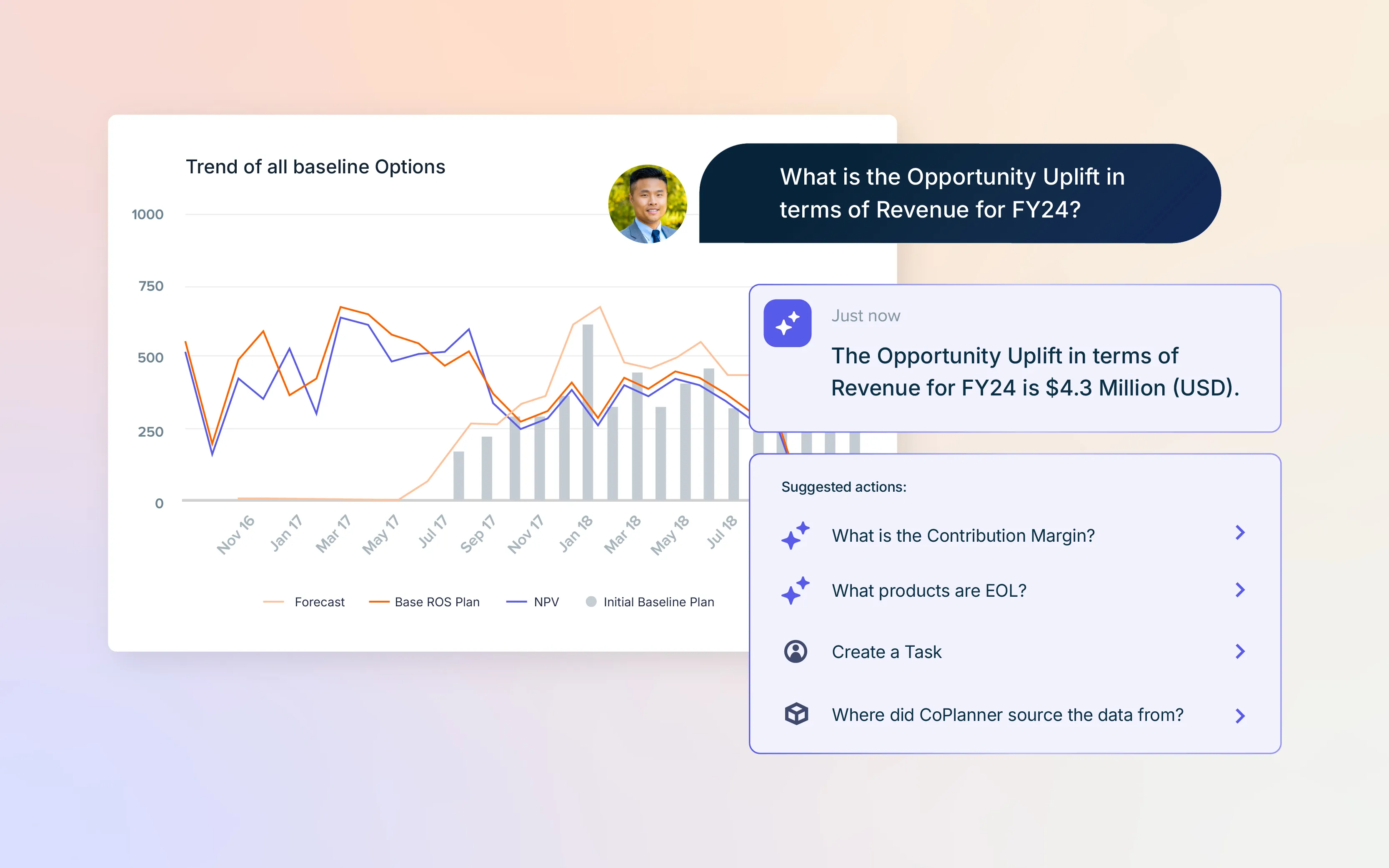
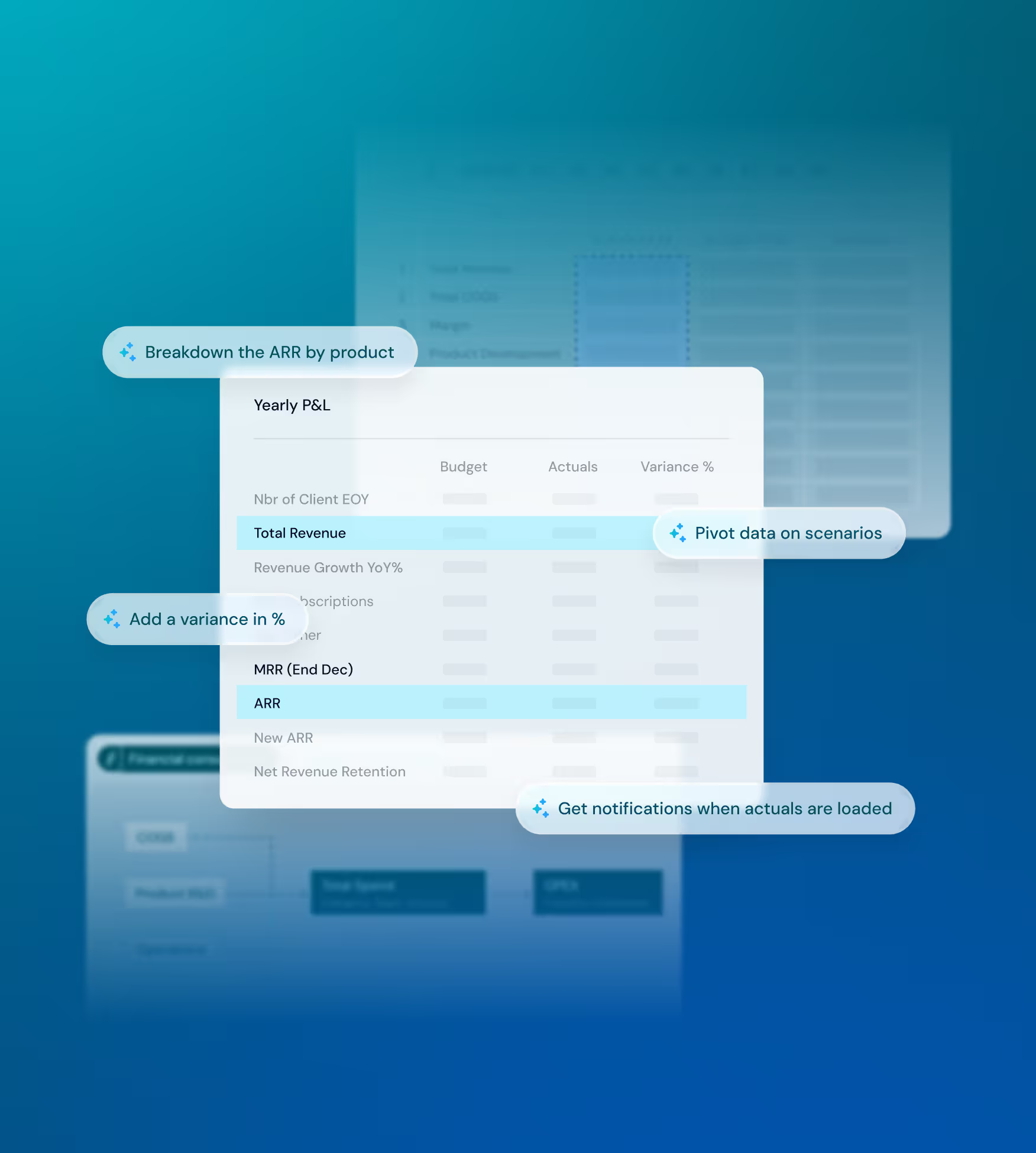


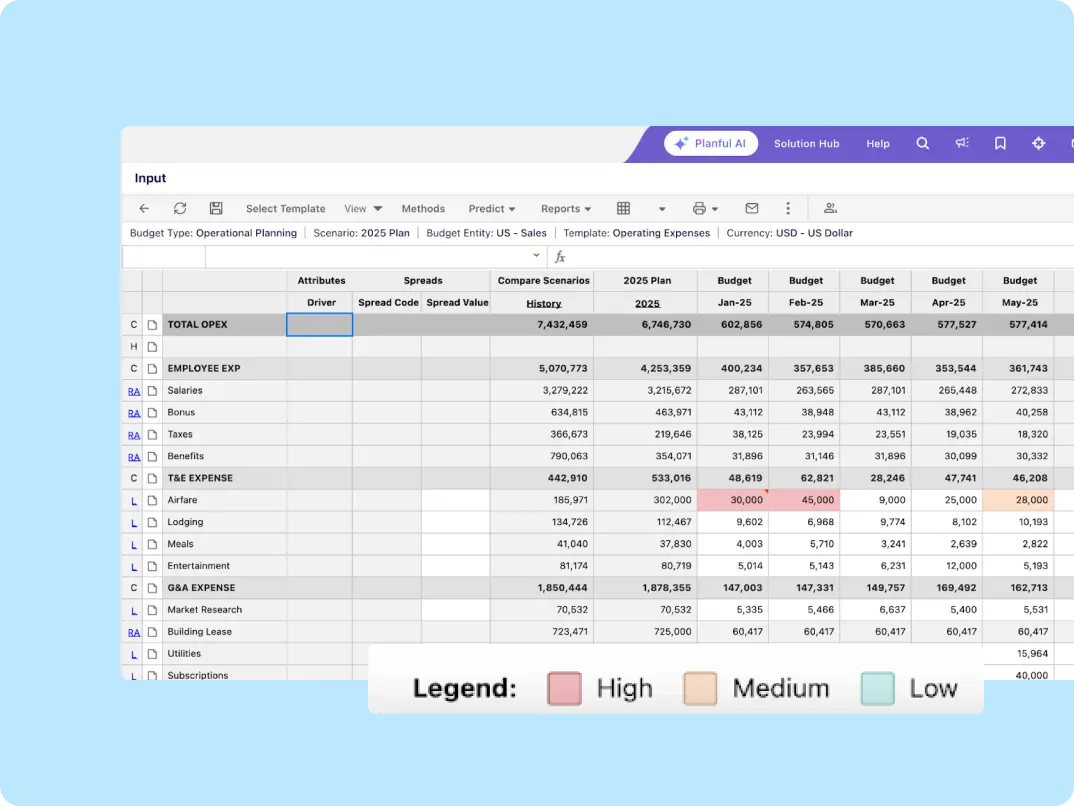
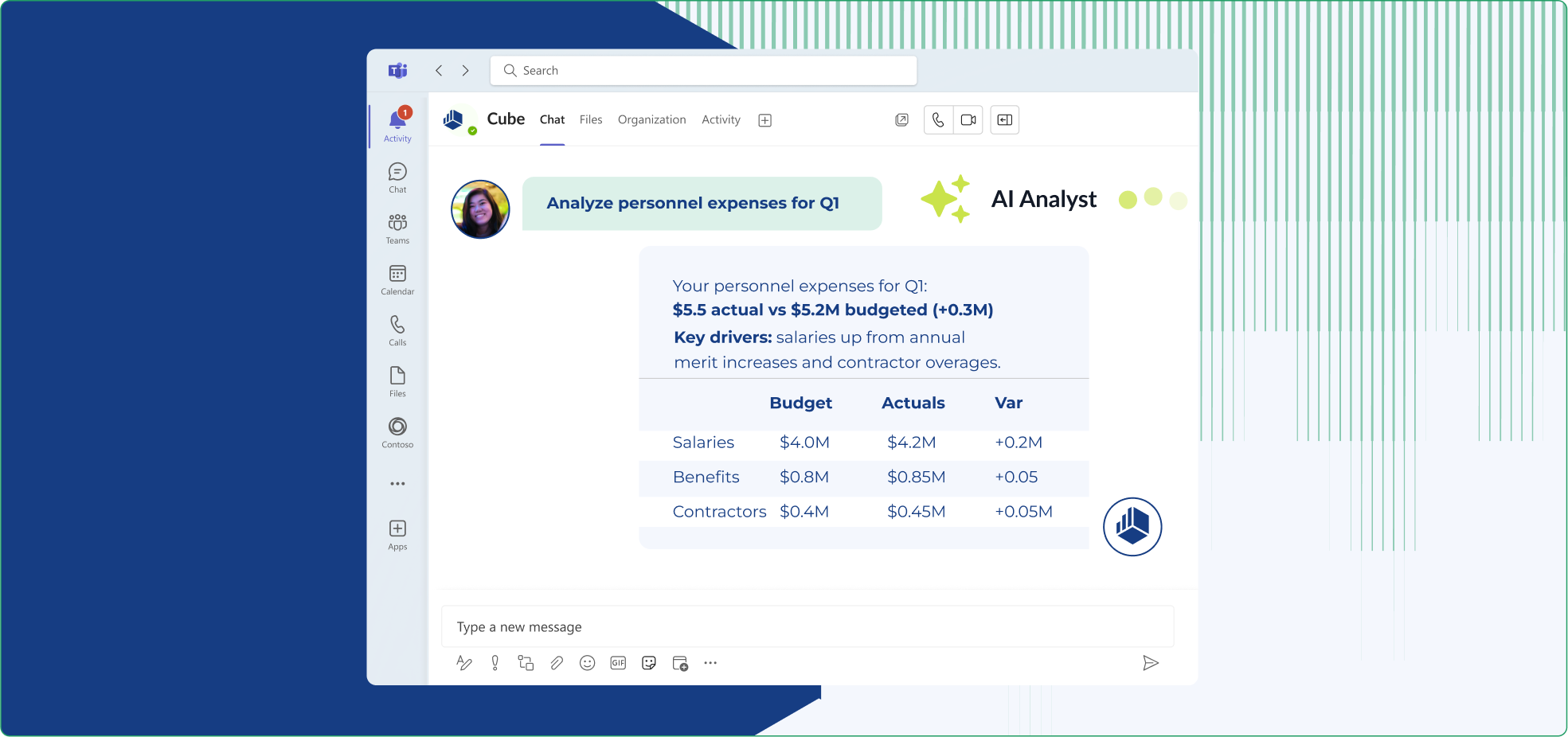
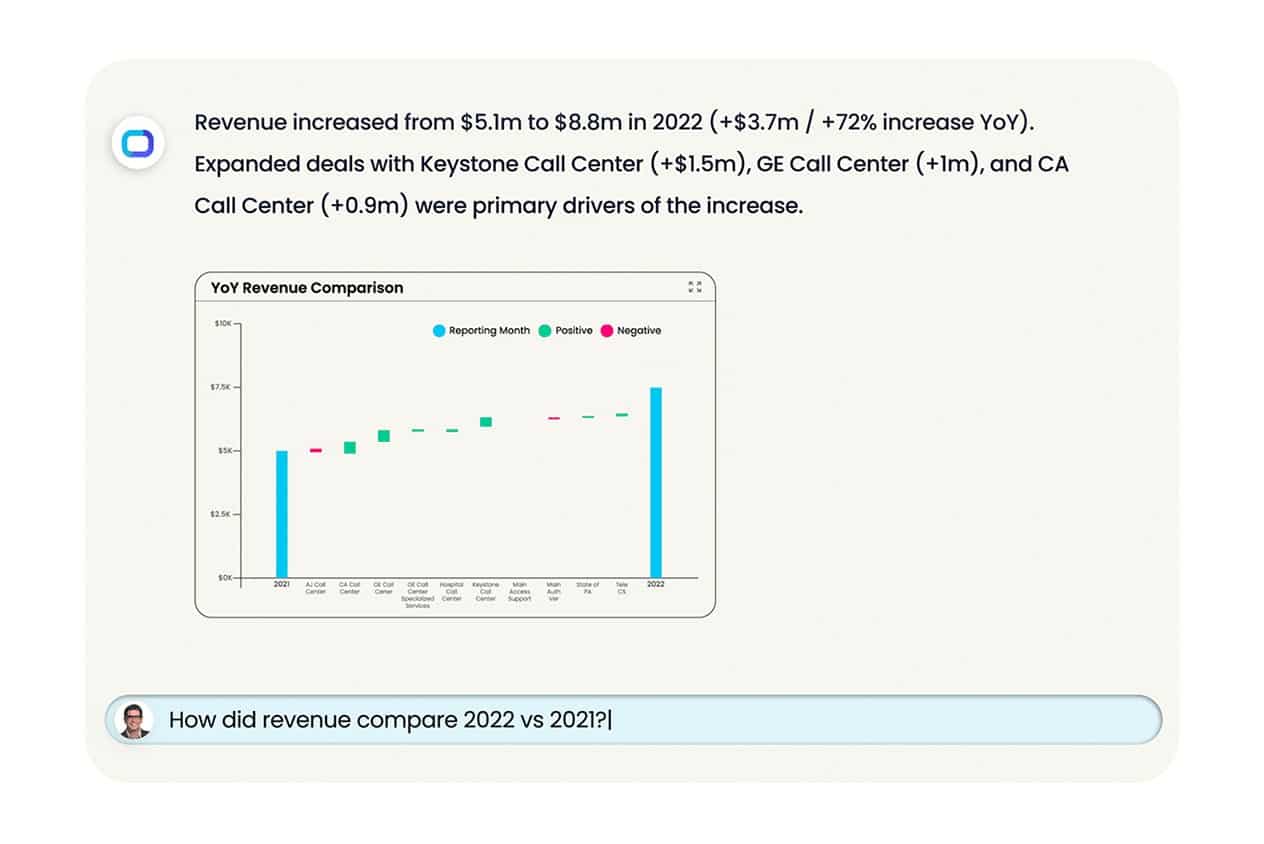
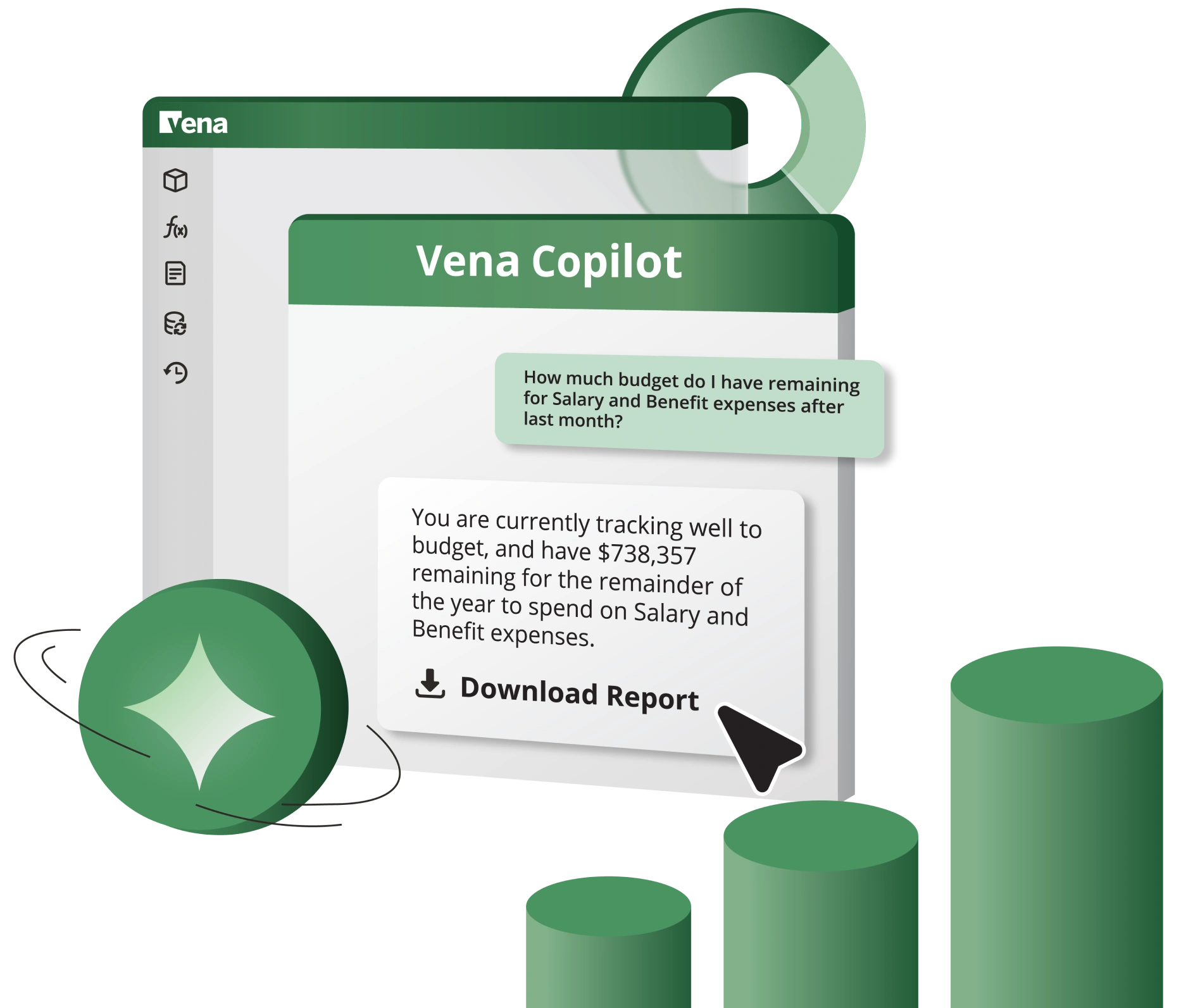







.svg)

